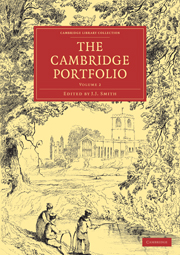Book contents
- Frontmatter
- DIRECTIONS FOR PLACING THE PLATES
- THOMAS HOBSON
- THE WOODWARDIAN MUSEUM
- ANECDOTES. II
- PORTRAITURE OF WILLIAM HARVEY
- THE HALL OF TRINITY COLLEGE
- JESUS COLLEGE
- OLD HOUSES
- CROMWELLI
- SOURCES OF HISTORY. IV
- EGYPTIAN ANTIQUITIES
- A VIEW FROM THE GARDENS OF CHRIST'S COLLEGE
- SAMUEL PEPYS
- KING'S COLLEGE
- THE PUBLIC LIBRARY
- ST. MARY'S CHURCH
- THE EXAMINATIONS
- THE CAMBRIDGE PRESS
- CRANMER
- ST. PETER'S COLLEGE
- MEMOIR OF A PHYSICIAN
- MILTON'S MULBERRY-TREE, AND BUST, IN CHRIST'S COLLEGE
- REMARKS ON THE INFERIOR STYLES OF DOMESTIC ARCHITECTURE
- THE POWTES COMPLAYNTE
- THE CAMBRIDGE SCHOLAR AND THE GHOST OF A SCRAG OF MUTTON
- INDEX
- ERRATA
- Plate section
KING'S COLLEGE
Published online by Cambridge University Press: 10 November 2010
- Frontmatter
- DIRECTIONS FOR PLACING THE PLATES
- THOMAS HOBSON
- THE WOODWARDIAN MUSEUM
- ANECDOTES. II
- PORTRAITURE OF WILLIAM HARVEY
- THE HALL OF TRINITY COLLEGE
- JESUS COLLEGE
- OLD HOUSES
- CROMWELLI
- SOURCES OF HISTORY. IV
- EGYPTIAN ANTIQUITIES
- A VIEW FROM THE GARDENS OF CHRIST'S COLLEGE
- SAMUEL PEPYS
- KING'S COLLEGE
- THE PUBLIC LIBRARY
- ST. MARY'S CHURCH
- THE EXAMINATIONS
- THE CAMBRIDGE PRESS
- CRANMER
- ST. PETER'S COLLEGE
- MEMOIR OF A PHYSICIAN
- MILTON'S MULBERRY-TREE, AND BUST, IN CHRIST'S COLLEGE
- REMARKS ON THE INFERIOR STYLES OF DOMESTIC ARCHITECTURE
- THE POWTES COMPLAYNTE
- THE CAMBRIDGE SCHOLAR AND THE GHOST OF A SCRAG OF MUTTON
- INDEX
- ERRATA
- Plate section
Summary
King's College was founded A.D. 1441, by Henry the Sixth. It was at first only intended for a Rector and twelve Scholars; but the foundation was remodelled in 1443, so as to consist of a Provost, seventy Fellows and Scholars, and ten Conducts, together with choristers and inferior officers. The ten Conducts are now merged into one; and with this exception the constitution of the college remains the same as it was in the founder's time. About 1446, Eton College was founded for seventy Scholars who were to supply the vacant scholarships at King's as they occurred. This practice still continues; and every year an election is held at Eton at the end of July, when the candidates for the King's scholarships at Eton are elected, and the vacancies at King's College filled up from Eton. The electors are the Provost and two Fellows of King's, called Posers, on the part of Cambridge, and, on the part of Eton, the Provost, Vice-Provost, and Head Master of that foundation. Eton Scholars are superannuated at the election after passing their nineteenth year; if not then elected they lose the power of becoming members of King's College. The first three years at King's are called years of probation, at the end of which the Scholar, if approved, is admitted to a Fellowship. The elections in both cases are made by seniority, without any reference to the merits of the candidates, though there is the form of an examination at Eton at the time of election.
- Type
- Chapter
- Information
- The Cambridge Portfolio , pp. 426 - 437Publisher: Cambridge University PressPrint publication year: 2010First published in: 1840

